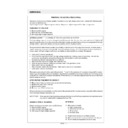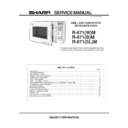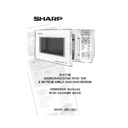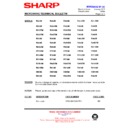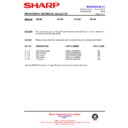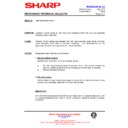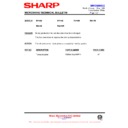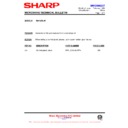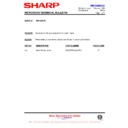Read Sharp R-871M Service Manual online
871M - 1
SERVICING
AFTER REPAIR REMEMBER TO CHECK 4R
1)
R
econnect all leads removed from components during testing.
2)
R
eplace the outer case (cabinet).
3)
R
econnect the supply.
4)
R
un the oven. Check all functions.
When all service work is completed, and the oven is fully assembled, the microwave power output should be checked
and microwave leakage test carried out.
and microwave leakage test carried out.
WARNING TO SERVICE PERSONNEL
Microwave ovens contain circuitry capable of producing very high voltage and current. Contact with following parts
will result in electrocution:-
High voltage capacitor, High voltage transformer, Magnetron, High voltage rectifier, High voltage wires.
will result in electrocution:-
High voltage capacitor, High voltage transformer, Magnetron, High voltage rectifier, High voltage wires.
REMEMBER TO CHECK 3D
1)
D
isconnect the supply.
2)
D
oor opened, and wedged open.
3)
D
ischarge high voltage capacitor.
WARNING AGAINST THE CHARGE OF THE HIGH-VOLTAGE CAPACITOR
The high-voltage capacitor remains charged about 60 seconds after the oven has been switched off. Wait for 60
seconds and then short-circuit the connection of the high-voltage capacitor (that is, of the connecting lead of the high-
voltage rectifier) against the chassis using a screwdriver with an insulated handle.
seconds and then short-circuit the connection of the high-voltage capacitor (that is, of the connecting lead of the high-
voltage rectifier) against the chassis using a screwdriver with an insulated handle.
Sharp recommend that wherever possible, fault-finding is carried out with the supply disconnected. In some cases, it
may be necessary to connect the supply with the cover removed to carry out fault investigation in the control circuitry.
In such cases, the high voltage circuit should be disabled as described below to reduce the hazards:-
may be necessary to connect the supply with the cover removed to carry out fault investigation in the control circuitry.
In such cases, the high voltage circuit should be disabled as described below to reduce the hazards:-
•
Carry out 3D checks (see above).
•
Disconnect the supply leads from the high voltage transformer, making a note of the polarity. Insulate the
connectors, ensuring they are positioned away from the transformer and fastened there.
connectors, ensuring they are positioned away from the transformer and fastened there.
•
Connect any relevant test equipment e.g. voltmeter.
•
Reconnect the oven to the supply, then close the door.
•
Note the results of the test, taking care to keep clear of the operational oven.
•
Carry out 3D checks (see above).
•
Reconnect the leads to the transformer. Take care to observe correct polarity.
•
Carry out 4R checks (see below).
Microwave ovens should not be used without a load. To test for the presence of microwave energy within a cavity,
place a cup of cold water on the oven turntable, close the door and set the microwave timer for one (1) minute, set the
power level to HIGH (100%) and push the start key. When the one (1) minute has elapsed (timer at zero) carefully check
that the water is now hot.
place a cup of cold water on the oven turntable, close the door and set the microwave timer for one (1) minute, set the
power level to HIGH (100%) and push the start key. When the one (1) minute has elapsed (timer at zero) carefully check
that the water is now hot.
IMPORTANT:
If the oven becomes inoperative because of a blown fuse F8A Fuse, check the monitored latch switch
and monitor switch before replacing the fuse F8A.
and monitor switch before replacing the fuse F8A.
WARNING: WIRING / RE-WIRING
Before carrying out any work; carry out 3D checks.
1) Disconnect the supply.
2) Open the door and wedge open.
3) Discharge the high voltage capacitor.
1) Disconnect the supply.
2) Open the door and wedge open.
3) Discharge the high voltage capacitor.
RE-WIRING
1) Wires must not touch:
a) High voltage parts.
b) Parts that become hot.
c) Sharp edges.
d) Movable parts.
b) Parts that become hot.
c) Sharp edges.
d) Movable parts.
2) Positive lock connectors are fitted correctly
3) Wires are connected correctly as per pictorial diagram.
4) No wire leads are trapped by the outer wrap.
3) Wires are connected correctly as per pictorial diagram.
4) No wire leads are trapped by the outer wrap.
871M - 2
WARNING
Servicing and repair work must be carried out only by
trained service engineers.
trained service engineers.
The parts marked '*' on the parts list and schematic
diagram have voltages in excess of 250V.
diagram have voltages in excess of 250V.
Removal of the outer wrap gives access to potential
above 250V.
above 250V.
All the parts marked "
∆
" on the parts list may cause undue
microwave exposure, by themselves, or when they are
damaged, loosened or removed.
damaged, loosened or removed.
CAUTION
MICROWAVE RADIATION
Do not become exposed to radiation from the
magnetron or other parts conducting microwave
energy. All input and output microwave connections,
waveguides, flanges and gaskets must be secured.
Never operate the device without a microwave
energy absorbing load attached. Never look into an
open waveguide or antenna while the device is
energized.
magnetron or other parts conducting microwave
energy. All input and output microwave connections,
waveguides, flanges and gaskets must be secured.
Never operate the device without a microwave
energy absorbing load attached. Never look into an
open waveguide or antenna while the device is
energized.
CAUTION / WARNING
WARNING
THIS APPLIANCE MUST BE EARTHED
IMPORTANT
THE WIRES IN THIS MAINS LEAD ARE COLOURED IN ACCORDANCE WITH THE FOLLOWING CODE:
GREEN-AND-YELLOW
: EARTH
BLUE
: NEUTRAL
BROWN
: LIVE
If the mains lead is replaced, only part number QACCBA030WRE0 should be used
OVEN
APPEARANCE VIEW
Door
Door hinges
Grill heating elements
Oven lamp
Wave guide cover
Control panel
Coupling
Door lock openings
Grill heating element (Bottom Heater)
Oven cavity
Door seals and sealing surfaces
Safety door latches
Ventilation openings
Outer cabinet
Rear cabinets
Power supply cord
871M - 3
ITEM
DESCRIPTION
Power Requirements
230 - 240 Volts / 50 Hertz / Single phase, 3 wire earthed
Power Consumption
Microwave cooking
1.55kW Approx. 7.5A
Dual cooking
(Microwave and Top Grill)
2.8kW Approx. 12A
(Microwave and Bottom grill)
2.35kW Approx. 10A
(Microwave and Convection)
2.3kW Approx. 10A
(Top and Bottom Grill)
2.05kW Approx. 9A
Convection cooking
2.08kW Approx. 9.1A
Grill Cooking
(Top Grill)
1.25kW Approx. 5A
(Bottom Grill)
0.85kW Approx. 3.5A
Power Output
900 watts nominal of RF microwave energy (measured by method of IEC
705) Operating fequency 2450 MHz
705) Operating fequency 2450 MHz
Grill heating element Power Output
Top Grill 1.2kW (600W x 2)
Bottom Grill 0.8kW
Case Dimensions
Width 520 mm
Height 309 mm (including foot)
Depth 488 mm
Cooking Cavity Dimensions
Width 349 mm
Height 207 mm
Depth 357 mm
Turntable diameter
325mm
Control Complement
Touch Control System
Microwave Cooking Control
Microwave Cooking Control
Repetition Rate;
HIGH .................. Full power throughout the cooking time
MEDIUM HIGH .................. approx. 70% of FULL Power
MEDIUM ........................... approx. 50% of FULL Power
MEDIUM LOW .................. approx. 30% of FULL Power
LOW .................................. approx. 10% of FULL Power
WEIGHT keys, INFO key
CONVENIENCE FOODS key
PIZZA key, AUTO COOK key
AUTO DEFROST key, AUTO START key
LESS(
)/MORE(
)
DUAL COOK, GRILL, MICROWAVE, CONVECTION
MINUTE TIMER
CLOCK SETTING, STOP/CLEAR
AUTO MINUTE/START
TIME KEY (10 MIN., 1MIN., 10 SEC.)
Set Weight
Approx. 20 kg
SPECIFICATION
PRODUCT DESCRIPTION
871M - 4
OFF CONDITION
Closing the oven door activates all door interlock switches
(monitored latch switch and stop switch.
(monitored latch switch and stop switch.
IMPORTANT:
When the oven door is closed, the contacts COM-NC of the
monitor switch SW2 must be open and the contacts (COM-
NO) must be closed. When the microwave oven is plugged
in a wall outlet (230-240V / 50Hz), 230-240 volts A.C. is
supplied to the point A1 + A3 in the control unit.
When the oven door is closed, the contacts COM-NC of the
monitor switch SW2 must be open and the contacts (COM-
NO) must be closed. When the microwave oven is plugged
in a wall outlet (230-240V / 50Hz), 230-240 volts A.C. is
supplied to the point A1 + A3 in the control unit.
1. The display starts demo mode.
2. To set any programmes or set the clock, you must first
2. To set any programmes or set the clock, you must first
touch the STOP key.
3. Information appears on display.
NOTE: When the oven door is opened, the oven lamp
NOTE: When the oven door is opened, the oven lamp
comes on at this time.
MICROWAVE COOKING CONDITION
HIGH COOKING
Enter a desired cooking time with the touching Number keys
and start the oven with touching START key.
and start the oven with touching START key.
Function sequence Figure O-1 on page 18
CONNECTED COMPONENTS
RELAY
Oven lamp, Turntable motor
RY1
High voltage transformer
RY2
Fan motor
RY5
1
When the cooking time is up, a signal tone is heard and
the relays RY1 + RY2 + RY5 go back to their home
position. The circuits to the oven lamp, high voltage
transformer, fan motor and turntable motor are cut off.
the relays RY1 + RY2 + RY5 go back to their home
position. The circuits to the oven lamp, high voltage
transformer, fan motor and turntable motor are cut off.
2. When the oven door is opened during a cooking cycle,
the switches come to the following condition.
Switch
Contact
Condition
During
During
Oven Door
Cooking
Open(No cooking)
Monitored latch Switch COM-NO
Closed
Opened
Monitor Switch
COM-NO
Closed
Opened
Monitor Switch
COM-NC
Opened
Closed
Stop switch
COM-NO
Closed
Opened
The circuit to the high voltage transformer, is cut off when the
contact of relay RY2 contacts COM-NO of the monitored
latch switch SW1, and monitor switch SW2 are made open.
The circuit to the fan motor is cut off when the relay RY5 is
made open. The circuit to the turntable motor is cut off when
the contacts COM-NO of the monitor switch are made open.
The relay RY2 and RY5 are made open when the door is
opened. The oven lamp remains on even if the oven door is
opened after the cooking cycle has been interrupted, because
the relay RY1 stays closed. Shown in the display is remaining
time.
3. MONITOR SWITCH CIRCUIT
contact of relay RY2 contacts COM-NO of the monitored
latch switch SW1, and monitor switch SW2 are made open.
The circuit to the fan motor is cut off when the relay RY5 is
made open. The circuit to the turntable motor is cut off when
the contacts COM-NO of the monitor switch are made open.
The relay RY2 and RY5 are made open when the door is
opened. The oven lamp remains on even if the oven door is
opened after the cooking cycle has been interrupted, because
the relay RY1 stays closed. Shown in the display is remaining
time.
3. MONITOR SWITCH CIRCUIT
The monitor switch SW2 is mechanically controlled by
the oven door, and monitors the operation of the monitored
latch switch SW1.
the oven door, and monitors the operation of the monitored
latch switch SW1.
3-1. When the oven door is opened during or after the cycle
of a cooking program, the monitored latch switch SW1
and stop switch SW3 must open their contacts (COM-
and stop switch SW3 must open their contacts (COM-
NO) first. After that the contacts (COM-NC) of the
monitor switch SW2 can be closed and the contacts
(COM-NO) of monitor switch SW2 are made open.
monitor switch SW2 can be closed and the contacts
(COM-NO) of monitor switch SW2 are made open.
3-2. When the oven door is closed. The contacts (COM-NC)
of the monitor switch SW2 must be opened and the
contacts (COM-NO) of monitor switch SW2 must be
closed. After that the contacts of the monitored latch
switch SW1 and the stop switch SW3 are made closed.
contacts (COM-NO) of monitor switch SW2 must be
closed. After that the contacts of the monitored latch
switch SW1 and the stop switch SW3 are made closed.
3-3. When the oven door is opened and the contacts of the
monitored latch switch SW1 remain closed, the fuse F2
F8A will blow. Because the relay RY1 and monitor
switch SW2 are closed and a short circuit is caused.
F8A will blow. Because the relay RY1 and monitor
switch SW2 are closed and a short circuit is caused.
3 seconds are needed for heating up the
magnetron filament.
magnetron filament.
32 sec. ON
24 sec. ON
18 sec. ON
12 sec. ON
6 sec. ON
8 sec. OFF
14 sec. OFF
20 sec. OFF
28 sec. OFF
HIGH
MEDIUM
HIGH
HIGH
MEDIUM
MEDIUM
LOW
LOW
LOW
Approx. 70%
Approx. 50%
Approx. 30%
Approx. 10%
Approx. 100%
MEDIUM HIGH, MEDIUM, MEDIUM LOW, LOW
COOKING
COOKING
When the microwave oven is preset for variable cooking
power, the 230-240 volts A.C. power is supplied to the high
voltage transformer intermittently within a 32-second time
base through the relay contact which is coupled with the
current-limiting relay RY2. The following levels of microwave
power are given.
power, the 230-240 volts A.C. power is supplied to the high
voltage transformer intermittently within a 32-second time
base through the relay contact which is coupled with the
current-limiting relay RY2. The following levels of microwave
power are given.
Note: The On/Off time ratio does not exactly correspond to
the percentage of microwave power, because approx.
Approx 100%
OPERATION SEQUENCE

